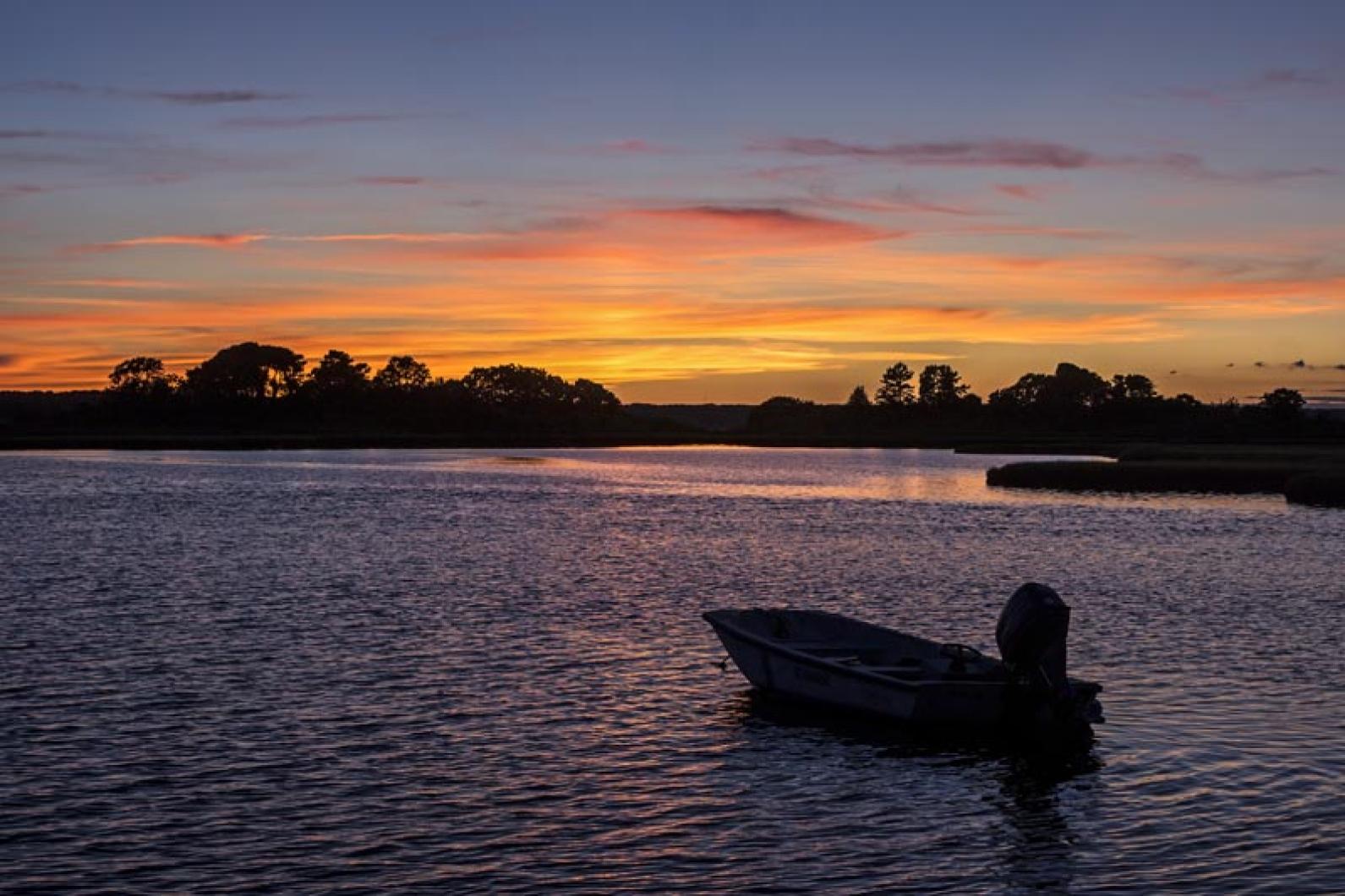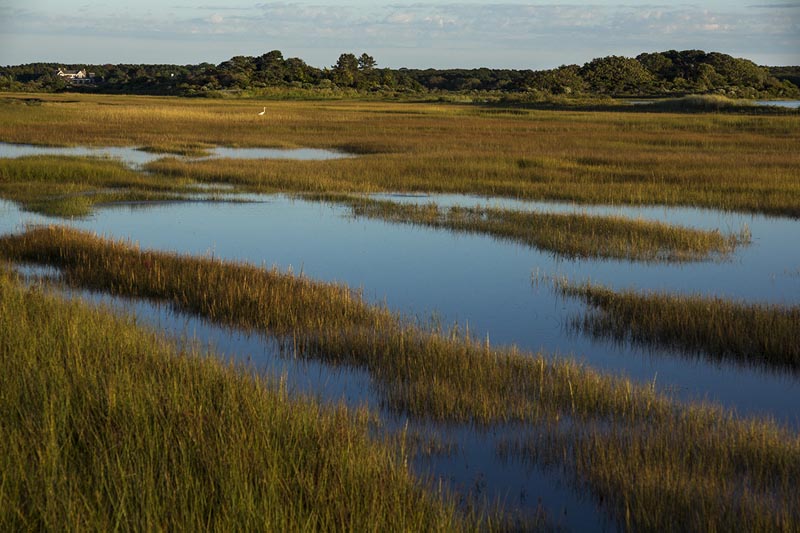With high levels of nitrogen in Sengekontacket Pond threatening everything from marine life to property values, state and local environmental officials have outlined an aggressive plan to clean up the pond that ranges from diverting wastewater from several watersheds to designating the entire pond as a district of critical planning concern.
The state executive office of energy and environmental affairs, the Massachusetts Department of Environmental Protection, and the Bureau of Resource Protection released a draft report this month noting that 58.8 kilograms of nitrogen per day enters the Sengekontacket estuary, well over acceptable limits, and leading to concentrations ranging from .21 milligrams per liter at the main inlet station to .61 milligrams per liter in Major’s Cove. The target threshold is .35 milligrams per liter per day, to allow for restoring eelgrass and infaunal habitat quality. To achieve that, the study said, the total maximum daily load of nitrogen would be 50 kilograms per day.
The executive summary of the draft report states that failure to reduce the nitrogen level could result in the loss of eelgass, a higher frequency of undesirable decreases in dissolved oxygen concentrations, fish kills, “widespread occurrence of unpleasant odors and visible scum,” and even a complete loss of macroinvertebrates that live on the pond floor.
“As a result of these environmental impacts, commercial and recreational uses of Sengekontacket Pond waters will be greatly reduced,” the report said.
The study showed the highest nitrogen levels are in Major’s Cove and Trapps Pond, while Farm Neck and Ocean Heights also periodically exceed the limit.
Edgartown conservation agent Jane Varkonda said the town will discuss the report’s findings at a meeting in October.
The report relates directly to the Massachusetts Estuaries Project, which began studying Island ponds several years ago in work that remains ongoing.
At the Oak Bluffs selectmen’s meeting Tuesday, Terri Appenzellar came armed with a jar containing algae from Bend in the Road beach, along with a bag of fertilizer marked with an “N” with a line through it.
Every seven or eight fertilized lawns increases nitrogen by an amount equal to a third of the daily input, Ms. Appenzellar said. “This is what we really have to get our minds wrapped around . . . our bottom line: No nitrogen.”
Ms. Appenzellar is a member of the Friends of Sengekontacket, an environmental advocacy and study group dedicated to protecting the pond, as well as the joint Edgartown and Oak Bluffs Sengekontacket Pond committee. Before the selectmen, she outlined several proposed avenues of remediation from the two-town committee and read from the committee’s recommendations. “Remediation and permanent reduction of daily nitrogen contribution are required,” the recommendations say in part.
The Massachusetts Estuaries Program, which released its report on Sengekontacket Pond last year, said the main goal should be to reduce nitrogen loading from subsurface wastewater disposal systems, either by sewering, nitrogen removal technology treatment, or advanced treatment of septage and installation of nitrogen reducing systems.
The plan calls for removing 56 per cent of septic waste water from the Major’s Cove watershed and 100 per cent of septic waste water from the Trapps Pond watershed, reducing fertilizer in the Farm Neck watershed, and filtering wastewater in Farm Neck and Ocean Heights watersheds.
The joint committee’s recommendations call for a public policy in Oak Bluffs and Edgartown to formally adopt the findings of the estuaries project report and further adopt bylaws or a district of critical planning concern (DCPC) designating the 4,440-acre pond a “cherished natural resource.”
The committee also recommends amending zoning bylaws to limit additional bedroom capacity as a result of sewering, pursuing funding for nitrogen removal systems for year-round residents, and testing residential drinking water wells.
One recommendation calls for adopting a septic system bylaw, similar to one in place in Vineyard Haven, mandating inventory and testing of septic systems with requirements for corrective action.
“We believe that funding options really need to be made available . . . some residents will have septic systems that need corrective action and not everyone can afford it,” Ms. Appenzellar said.
The suggested DCPC would include 500-foot setbacks from wetlands or coastal zones, a prohibition on building, inappropriate landscaping or uncorrected runoff, and a maximum square footage allowed for lawns and impervious surfaces.
The committee additionally calls for collaboration between towns and by planning boards, health departments, conservation commissions, wastewater commissions and water and shellfish departments — and the funding for necessary remediation, restoration, maintenance and public awareness.
The Friends of Sengekontacket sent letters to 86 homeowners abutting the pond encouraging residents to help improve water quality. Suggestions include using only organic fertilizer (if any), avoiding overwatering, reducing lawn size, testing septic systems, and planting a buffer strip of native vegetation to help filter pollutants before going into the pond.
Ms. Appenzellar said that there is a large tax base affected by “an unsightly smelly pond,” with 32 Oak Bluffs houses worth $50 million in assessed property and 56 Edgartown houses worth an assessed $80 million bordering the pond.
“This is not a small issue in terms of financial consequences,” she said.
The Oak Bluffs selectmen listened with interest. Selectman Gail Barmakian noted that developing a plan to expand the wastewater system and study nitrogen loading in Sengekontacket and other bodies of water is on the selectmen’s strategic plan for fiscal year 2013. She noted that when it comes to measures already taken, Oak Bluffs is “ahead of the game” compared to Cape Cod.
Town administrator Robert Whritenour said he would ask for an extension of the comment period in response to the study, and he aims to “try to get a copy of that report in the hands of every stakeholder.”
While the town can submit comments, Mr. Whritenour said, the state will decide whether to adopt the program and Oak Bluffs then has to follow the rules. “This will be our guidepost,” he said.
“I think we have a lot of work to do,” selectman and board chairman Kathy Burton said.






Comments
Comment policy »